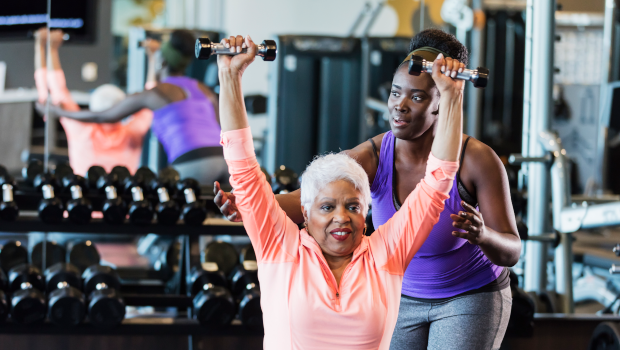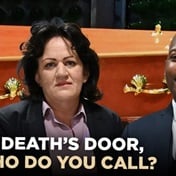
It won’t prevent your hair from going grey or your eyesight from Failing but exercise can help with some of the symptoms of ageing. Studies show things like cognitive Impairment, muscle wasting, bone Thinning and cardiovascular dam- Age is different in people who exercise often compared to those who don’t. It may get harder as you get older but Age isn’t an excuse to avoid physical Activity. And it doesn’t have to be too Hectic or time-consuming.
Some health authorities say just 10 Minutes of brisk walking a day can re- Duce the risk of early death by up to 15%. They suggest adults attempt at least 150 minutes a week of moderate to vigorous physical activity, which has also been linked to cutting the risk of diabetes by 40%, cardiovascular disease by 35%, and dementia by 30% and some cancers by 20%. “We all know exercise is good for us but most adults, even young ones, don’t get the recommended amount of physical activity,” says Grace Pholi, a bio- kinetics at the Sport Science Institute of South Africa.
SO HOW DO WE GET STARTED?
“Whatever your age, the first step is to find time for exercise,” she says. “Make a schedule according to your routine – maybe short breaks during the day work better for you than early morning or after work. The next step is to find what you enjoy.” If it’s not enjoyable, chances are it won’t be sustainable. And that’s where motivation comes in.
“The key to success is mental fitness,” says Zanele Sikhakhane, a personal trainer with Virgin Active. “If you’re mentally fit, you can do any- thing. A person in their 50s can be fitter than someone in their 20s, and new training methods suggest there’s no need to change what people do just because they’re older. They can still do most things, but at a slower pace.” Now that people are living longer, exercise is more important than ever. It’s about functionality – living well, not just longer. Let’s look at our bodies and what we can do for them during the different stages of our lives.
20S and 30S
It’s all about cardio at this age. If you’re fit now, you have a much better chance of being healthy later. “Cardio strengthens the heart and lungs, lowering the chances of things like heart disease, high blood pressure and diabetes,” Pholi says. “When you want to build cardio- vascular health in general you must use different forms to improve it, so diversify by using a bike as well as swimming or using the treadmill.”
At this age she recommends 30-60 minutes of moderate intensity exercise five days a week or 20-60 minutes of vigorous intensity exercise three days a week. Sikhakhane favours functional training that trains your muscles to help you do everyday activities. For example, squats, lunges and box jumps build different parts of your body, which helps with daily tasks like picking something up. In your 30s your metabolism starts to slow down so it’s vital to keep up that fitness, or make a start, to avoid packing on the kilos.
“You’ll need resistance training – which could come in the form of free weights, weight machines or body weight – to help build muscle mass and strength,” Pholi says. “Generally the rule is lower reps (usually 6-8), higher load for strength and power; and high reps (12-15), low load for endurance.” Your core needs to be worked on from beginning to end, so once you have some strength try not to lose it. “People who know how to activate their core muscles have a better chance of reducing or avoiding injuries,” Pholi says. “It’s important for postnatal care, as many women lose their pelvic-floor function after the trauma of birth.”
40S and 50S
Although it begins in your 30s, bone density problems become more of an issue now, especially for women going through menopause. The solution is weight-bearing exercises. “Strength training is vital for bones,” Sikhakhane says. “Start with bodyweight or light weights and keep it simple until you see progress. In your 50s you can still do everything, but you might need to take things down a notch and modify exercises.
“For example, do a plank on your knees or a squat with a ball against a wall. But you still need to push because when your body gets used to something you won’t build or improve. Just make sure you push safely.” Pholi says this is a time to focus on other areas as well. “Strong muscles allow you to move but you also need flexibility,” she says. “Stretch tends to be ignored, but our joints and ligaments also require attention, so people need to be able to work through a range of motion.” Pilates and yoga are good choices at this age, she says.
60S and over
The main concern at this age is muscle decline, which can be tackled with weight- bearing and resistance training to build strength. It’s admittedly harder at this age, but it’s still possible – as long as you choose something your body can cope with. Mat- based exercises, Pilates and swimming all work well for this, Sikhakhane says. After 50 your balance and stability also decline, and if your bones are porous then you risk fractures if you fall. This means you need to keep working on your core muscles to help stability.
Pholi suggests simple exercises that can be done at home like standing on one leg when you brush your teeth or walking heel to toe along a straight line on the floor. And if you need more motivation to get active, research suggests exercise has a double benefit at this age – it works on your body and your brain. One study showed that regular dancing can reduce the risk of dementia by 76% – that’s twice as much as reading!


















